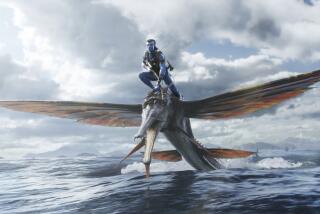One more time with feeling?
- Share via
In the kinder, gentler, dare I say more soulful new Lara Croft movie, Angelina Jolie doesn’t just glower -- she glowers with one eyebrow slightly raised. In any other movie this discreet gesture might go unnoticed, but in an industrial product like “Lara Croft Tomb Raider: The Cradle of Life,” any suggestion of humanity deserves notice. That’s especially true given that this blockbuster season has thus far been typified by what might be called post-human cinema, one in which nothing -- including most of the characters -- bears any resemblance to real life.
Lara Croft, of course, originated in a video game in which real life is pointedly irrelevant. What’s relevant to Lara and her legions of fans are her fantastically pneumatic breasts, her awesomely phallic weaponry and the way those breasts and weapons conspire to create a polymorphic fantasy. The target audience for point-and-shoot video games is mostly adolescent boys, but Lara’s take-charge cosmopolitan isn’t a bad fantasy for the rest of us, either. Although she’s modeled in part on the sort of colonial adventurer of which the British were once so fond, like H. Rider Haggard’s Allan Quatermain (“King Solomon’s Mines”), Lara also recalls such sleek imports as Mrs. Emma Peel, the cat-suited Avenger with the long, mean kick.
Always one for a grand entrance, Ms. Lara Croft enters her new film escapade astride a Jet Ski, executing motorized flips over the Aegean like a hyperactive dolphin. Dressed in a chic black bikini that doesn’t ride up no matter what, she quickly changes into a silver wet suit that makes her look ready to pop into the microwave. Instead, bookended by a pair of strapping Greek lads, she pops into the water to go hunting for sunken treasure. She finds it, along with a mess of trouble and a cavalcade of stereotypes involving the usual faceless Asian hordes, a sinister British scientist (Ciaran Hinds), a strapping African warrior (Djimon Hounsou) and a mysterious African tribe so tolerant they don’t break stride when this freaky white woman starts bossing them around.
Lara has that effect on people, or at least on men. The story pivots on the world’s toughest chick, but nearly everyone else with lines in the movie is a man, most of whom -- when not trying to kill her -- are anxiously tending to her every action-adventure need. About the only other woman with dialogue is a diminutive Chinese peasant who isn’t surprised when Lara crash-lands in her yard. (“I tuned up your motorcycle,” says the old gal with a smile.)
Ferociously independent and action-oriented, Lara embodies a new kind of pinup that’s as much a creature of the post-feminist universe as the post- Title IX one. She can outrun and outgun any man but isn’t averse to flipping the right guy (Gerard Butler) on his back as she brandishes some of her assets.
Directed by Jan De Bont, whose previous spectaculars include “Speed” and a few less thrill-worthy titles (“Twister,” “The Haunting”), the newest Lara Croft vehicle signals a distinct if distinctly minor improvement on the first. Plugging the movie, the filmmakers recently vowed in Entertainment Weekly that this time there would be a script for Lara to follow and some emotional texture, but the thin concept of Dean Georgaris’ screenplay proves this was a bold and empty boast.
As in the first movie, Lara embarks on a globetrotting, gun-blazing mission to save the world by recovering an enchanted relic. What thickens the sequel’s plot ever so modestly is that this antique leads straight to Pandora’s box, that age-old root of all evil and great cautionary metaphor for the perils of female curiosity.
Georgaris doesn’t do anything with this richly suggestive metaphor, but it hovers over the movie nonetheless. However caricatured a vision of female empowerment, Lara Croft exercises an irresistible tug not just on the adolescent male imagination but the 12-year-old female imagination as well. She may wear a bikini worthy of a Bond girl, yet Lara is also tough, resourceful, wildly rich, stunningly beautiful and fiercely independent.
De Bont mounts a couple of acceptable action scenes (and a few clunkers), but it’s instructive of Lara’s appeal that the best scene in the movie finds her on horseback. Riding sidesaddle with a long duster billowing behind her, Lady Croft looks the very picture of today’s gentlewoman -- at peace with the world and herself, idyllically content with her horse, her solitude and her very, very large gun.
More to Read
Only good movies
Get the Indie Focus newsletter, Mark Olsen's weekly guide to the world of cinema.
You may occasionally receive promotional content from the Los Angeles Times.









